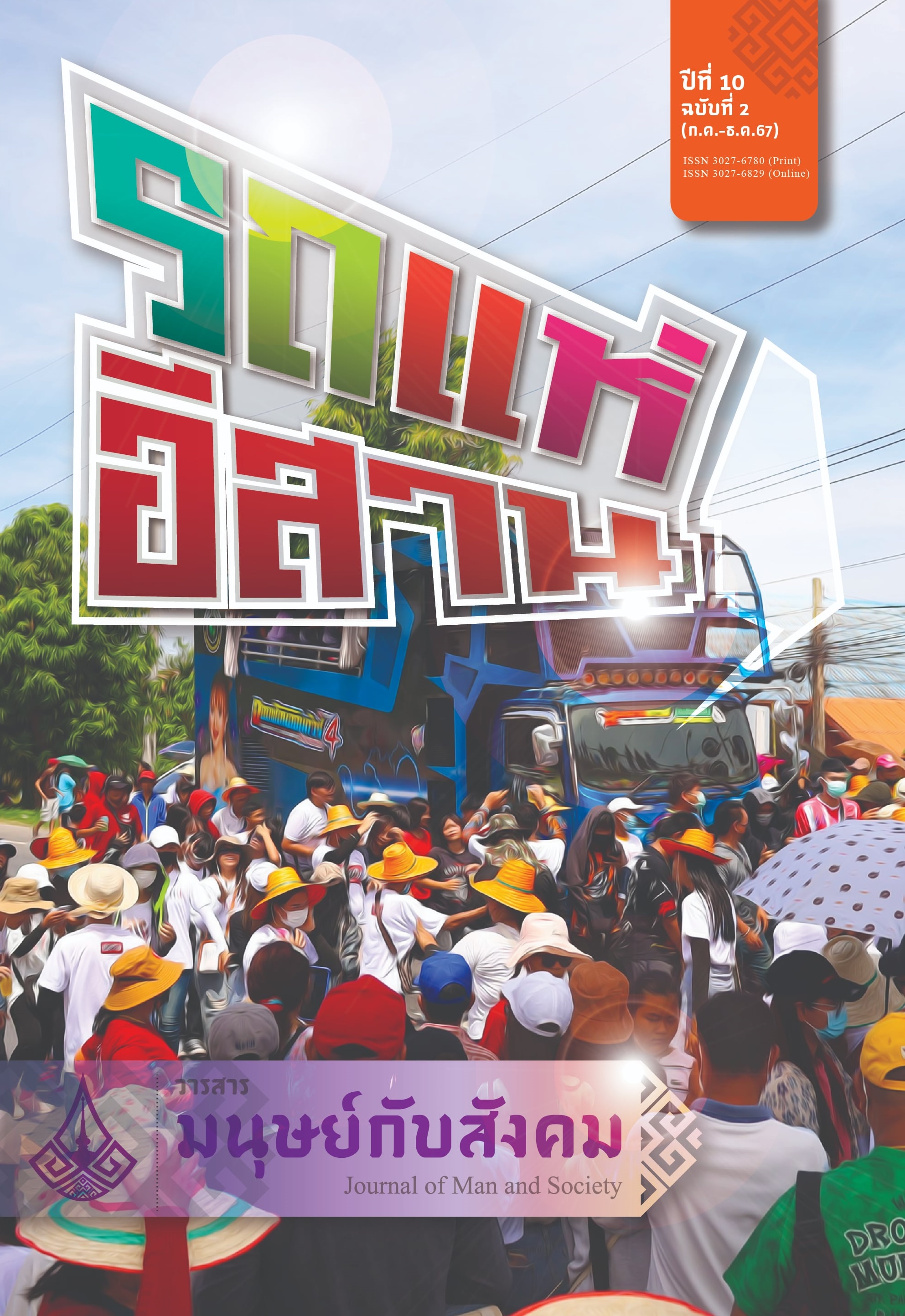Participatory Action Research to Develop Cultural Capital through the Creative Economy to the Cultural Community Tourism Connection in the Ancient City of Nakhon Lampang
Main Article Content
Abstract
This research aimed to 1) examine the potential of community cultural tourism based on cultural capital in the old city of Nakhon Lampang, 2) develop the potential of community cultural tourism through cultural capital in the same area, and 3) develop the potential of cultural tourism business operators by leveraging cultural capital and a creative economy in the old city of Nakhon Lampang. The research method used a participatory action research model and focused on three communities: Na Kuam Nuea, Na Kuam Tai, and Phra That, located in Mueang District, Lampang Province. The research tools included a tourist needs questionnaire, an assessment of community potential for cultural tourism and semi-structured interviews. The results found that fostering a creative economy through cultural community tourism can utilize national culture, which holds significant economic value, as a resource to generate income, promote societal stability, and ensure a better quality of life for the community. The cultural capital of the tourist communities in the old city of Nakhon Lampang is rich, encompassing unique folk literature preserved in palm manuscripts and traditional craftsmanship that is integrated into daily life. Key guidelines for developing the potential of cultural tourism communities include 1) improving the environment and adjusting the landscape, 2) designing engaging activities to promote tourism, 3) managing knowledge and creating learning resources, 4) strengthening the creative economy, 5) adding value to local products and services, and 6) elevating the quality of creative products. To further develop cultural tourism business operators, it is essential to focus on knowledge management, create historical and cultural learning resources, and creative economy principles. Additionally, opening new economic areas that offer unique, creative tourist experiences will enhance the region’s appeal as a cultural tourism destination.
Article Details

This work is licensed under a Creative Commons Attribution-NonCommercial-NoDerivatives 4.0 International License.
เนื้อหาและข้อมูลที่ตีพิมพ์ลงในวารสารมนุษย์กับสังคม ถือเป็นข้อคิดเห็นและความรับผิดชอบโดยตรงของผู้เขียนซึ่งกองบรรณาธิการวารสารไม่จำเป็นต้องเห็นด้วยหรือร่วมรับผิดชอบใดๆ
บทความ ข้อมูล เนื้อหา รูปภาพ ฯลฯ ที่ได้รับการตีพิมพ์ในวารสารมนุษย์กับสังคม ถือเป็นลิขสิทธิ์ของวารสาร หากบุคคลหรือหน่วยงานใดต้องการนำทั้งหมดหรือส่วนหนึ่งส่วนใดไปเผยแพร่ต่อต้องอ้างอิงวาสาร
References
กนกพร ศิริโรจน์, อุบลวรรณ หงส์วิทยากร, และละเอียด ศิลาน้อย. (2561). แนวทางการส่งเสริมการเรียนรู้ของชุมชนเพื่อพัฒนาการท่องเที่ยวเชิงสร้างสรรค์. Journal of Education Studies, 47(3), 1-24.
กระทรวงท่องเที่ยวและกีฬา. (2564). โครงการท่องเที่ยวเพื่อชีวิตและธรรมชาติ แผนปฏิบัติการท่องเที่ยวเชิงนิเวศแห่งชาติ. สำนักงานปลัดกระทรวงการท่องเที่ยวและกีฬา. https://secretary.mots.go.th/download/PDF/Action%20Plan%20for%20Tourism%20Development.pdf
คณะกรรมการบริหารงานจังหวัดแบบบูรณาการจังหวัดลำปาง. (2564). แผนพัฒนาจังหวัดลำปาง 5 ปี. (พ.ศ.2561 – 2565) ฉบับทบทวน ปี2564. สำนักงานจังหวัดลำปาง. https://www.lampang .go.th/ strategy/2566/plan-r66-70-t68.pdf
จักรกวี ซื่อตรง. (2559). การศึกษาวิถีชีวิตชุมชนกับการอนุรักษ์แม่น้ำท่าจีน: กรณีศึกษาชุมชนในตำบลย่านยาว อำเภอสามชุก จังหวัดสุพรรณบุรี. ใน นภัทร วัจนเทพินทร์ (บ.ก.), วิจัยเพื่อสร้างสรรค์ชุมชนและสังคม Research for Creating Community and Society. การประชุมวิชาการระดับชาติ มหาวิทยาลัยเทคโนโลยีราชมงคลสุวรรณภูมิ ครั้งที่ 1 (The 1th RUSNC) (น. 678-685). มหาวิทยาลัยเทคโนโลยีราชมงคลสุวรรณภูมิ.
ชูวิทย์ ศิริโชคเวชกุล. (2551). เที่ยวให้รู้ เปิดประตูสมอง (พิมพ์ครั้งที่ 1). เอ็กซพลอเรอร์ ชาแนล.
นุทิศ เอี่ยมใส. (2555). ทุนทางศิลปวัฒนธรรมประเพณีกับการพัฒนาความเข้มแข็งของชุมชนในจังหวัดเพชรบูรณ์. [รายงานการวิจัย]. มหาวิทยาลัยราชภัฏเพชรบูรณ์.
ปาวีณา โทรแก้ว. (2554). ธุรกิจการท่องเที่ยวเชิงวัฒนธรรมเผ่าลีซอจังหวัดเพชรบูรณ์ มหาวิทยาลัยราชภัฏเพชรบูรณ์. [รายงานการวิจัย]. มหาวิทยาลัยราชภัฏเพชรบูรณ์.
แพรภัทร ยอดแก้ว. (2565). แนวคิดเศรษฐกิจสร้างสรรค์กับการพัฒนาผลิตภัณฑ์เชิงสร้างสรรค์ของกลุ่มชาติพันธุ์ลาวครั่งในจังหวัดนครปฐม. ใน วิรัตน์ ปิ่นแก้ว (บ.ก.), วิจัยสร้าง Innovation and Technology เพื่อรองรับสังคมไทยสู่ Digital World. การประชุมวิชาการระดับชาติ ครั้งที่ 14 มหาวิทยาลัยราชภัฏนครปฐม (น. 2873-2885). มหาวิทยาลัยราชภัฏนครปฐม.
วรภูริมูลสิน และกอปรกมล ศรีภิรมย์. (2561). พิธีบายศรีสู่ขวัญบ้านโคกเมือง อำเภอประโคนชัย จังหวัดบุรีรัมย์ การผลิตซ้ำทุนทางวัฒนธรรมเพื่อการท่องเที่ยว. สารอาศรมวัฒนธรรมวลัยลักษณ์, 19(1), 61-78.
สายันต์ ไพรชาญจิตร์. (2550). การจัดการทรัพยากรทางโบราณคดีในงานพัฒนาชุมชน. โครงการหนังสือโบราณคดีชุมชน. หอสมุดแห่งมหาวิทยาลัยธรรมศาสตร์. https://digital.library.tu.ac.th.
เสาวภา ไพทยวัฒน์. (2555). การดำรงอยู่ของวัฒนธรรมชุมชนในสังคมเอง กรณีศึกษาชุมชนซอยโซดาและชุมชนวัดประชาระบือธรรม 1-4 เขตดุสิต กรุงเทพมหานคร. [รายงานการวิจัย]. มหาวิทยาลัยราชภัฏสวนสุนันทา.
สำนักงานปลัดกระทรวงวัฒนธรรม. (2562). ความหมายของมรดกภูมิปัญญาทางวัฒนธรรม และหมวดหมู่ของ มรดกภูมิปัญญาทางวัฒนธรรม. มรดกภูมิปัญญาทางวัฒนธรรมของชาติ. http://ich.culture.go.th/
สำนักงานปลัดกระทรวงวัฒนธรรม. (2562). วัฒนธรรมสร้างสรรค์. บริษัท รุ่งศิลป์การพิมพ์ จำกัด.
Bourdieu, P. (1984). Distinction: A Social Critique of the Judgement of Taste. Translated by Richard Nice. Routledge.

